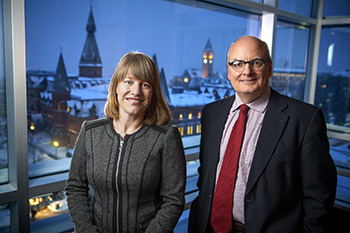CORNELL AT 150

Rendering of possible future campus planning.
The future campus: Walkable, sustainable, shaped by founder's vision
In the spring of 1865 Ezra Cornell drilled into the bedrock atop Libe Slope and kept a heap of dirt as a memento. His decision to build a campus there overrode the opinions of his son, his lawyer and his co-founder, A.D. White. It was Ezra's farm, after all: He knew best.
His enduring vision makes it a safe bet that the alma mater will be heard above Ithaca's valleys and hilltops well into the future. What might the Cornell campus look like 50 years from today, as the university marks its bicentennial? While this is a fanciful exercise, it is a tempting one, since the physical campus has changed in so many ways over the past century and a half.
Many of those future changes will reflect 21st-century challenges facing the university and showcase the Cornell community's answer to them.
The university's campus master plan, adopted in 2008, established Cornell's commitments to support the academic mission, create a welcoming campus experience, preserve its unique heritage and natural assets, and to encourage sustainable growth. In 2009 President David Skorton launched the Climate Action Plan to reach carbon neutrality by 2050 (the target year recently was accelerated to 2035).
A "living document," the master plan emphasizes a compact campus that is socially and physically interconnected; walkable and bikeable; accessible; and expandable eastward, for academic and administrative units linked to campus by an interconnected transit network.

Leslie Schill and Gilbert Delgado. See larger image
More mixed uses and a greener oasis
University Planner Leslie Schill and University Architect Gilbert Delgado oversee physical planning of campus and its lands as well as the architectural aesthetic for the university, which is "quite a bit like a small city," says Schill. This multifaceted work is daunting and inspiring.
One challenge: to meet the need for new types of learning, teaching and social spaces while reducing the university's energy use and environmental footprint. Cornell has reduced its overall emissions by almost 50 percent since 1990, and 32 percent since 2008, despite significant campus growth over the last two decades. To reach current climate goals, it is critical to build on this success, Schill and Delgado say.
Delgado tosses the question of what the future campus may look like into a time machine: "It's a tough question. Just think what planners in 1965 imagined Cornell would look like today," he says. The main campus has 628 buildings on more than three square Tompkins County miles, trafficked by more than 20,000 students and almost 10,000 faculty and staff.
"The campus growth of 50 years ago focused on engineering and the sciences as independent areas of study," Schill says. "Today, we see cross-disciplinary learning, teaching and interaction expanding across the university. Our goal will be to create and preserve great places that foster exciting academic connections."
Economics, technology, climate and the area's topography will be central to the design of the campus. Delgado and Schill see a stronger focus on public transportation and walking (creating an engaging, pedestrian-friendly experience throughout) as a means to sustainably connect the campus.
"The campus of tomorrow will likely include a greater mix of uses, where students, faculty and staff learn, work, live and play – a place that engenders a strong sense of community," Schill says. But a few critical gaps must be addressed, such as new housing for graduate students and new faculty; a multimodal transportation system that prioritizes walking and biking; and a balanced approach that preserves Cornell's open, green campus and historic buildings in addition to planning for new facilities.
But rather than a campus with many more new buildings, the future Cornell may well repurpose existing buildings for new academic and functional spaces, together with enlivened public spaces and walkways, Delgado says. He describes a potential future that could look like the past – with ground-floor interior spaces spilling into outdoor public areas. High-occupancy classrooms on ground floors will be triangulated with cafés and public seating areas.
If future learning will increasingly take place outside the classroom, Delgado says, the public realm – social spaces where students and faculty can discuss ideas or individually study – become more important.
Unlike a 1965-era prediction of Cornell in 2015 – a "Jetsons"-type Orbit City campus, hovercrafts, space-age fashion – the developing view of Cornell on its 200th birthday looks far more like an oasis for learning, living and research where ideas are freely discussed.
The core of campus
The future is already here: Lake Source Cooling and the conversion of the university's Combined Heat and Power Plant away from coal; Tower Road's transformation into a "complete street" with green infrastructure design; and new and refurbished buildings that reduce energy use.
Further collaboration with communities adjacent to Cornell also will be important. Development in Collegetown, East Hill Plaza and downtown Ithaca – areas identified for densification – will ensure that the greater Ithaca community continues to be dynamic and vibrant, Schill says.
But what will it look like? The founder's views remain sacrosanct.
"The core of the campus, the quads and places like Ho Plaza, the stunning views from Libe Slope – they will remain integral to the future campus," says Schill.